Introducing Solids to Baby 101: Everything You Need to Know
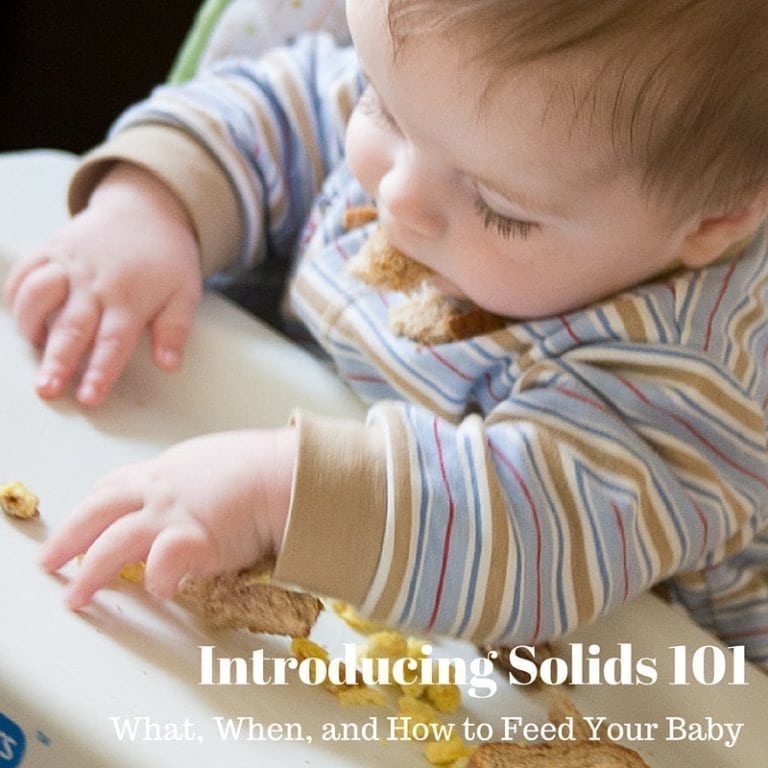
How to Feed Baby Solids
One of the most debated topics in the parenting world is how to feed your child.
I usually sit back and watch these, because they can get intense! And really, most of these fights seem to happen amongst complete strangers…which is silly.
With that said, I do think it’s important to know all your options – and there are a lot of them.
You might find yourself frustrated with a baby who refuses all purees – and you might be relieved to find out puree/spoon feeding isn’t for everyone.
So, I thought I’d share some basic information on introducing solid foods, so if you have come to that point in your baby-rearing journey, you can make the best decision for your family and child!
Baby Food 101
Breast milk or Formula Should Be #1
Your baby should really be getting the majority of their nutrition from breastmilk or formula for the first year.
Introducing solids during the first year is important, and it’s not something you should just skip. It helps to introduce new flavors and textures, avoid food allergies, and it helps to develop essential skills.
But it should not replace breast milk or formula.
Most of their calories won’t be coming from solid foods. So don’t feel too stressed out about getting in three meals a day and three snacks or anything like that right off the bat!
Who is what the WHO says:
“Around the age of 6 months, an infant’s need for energy and nutrients starts to exceed what is provided by breast milk, and complementary foods are necessary to meet those needs. An infant of this age is also developmentally ready for other foods. If complementary foods are not introduced around the age of 6 months, or if they are given inappropriately, an infant’s growth may falter.”
So no, the phrase “food before one isn’t just for fun” isn’t really true – it just doesn’t need to be a HUGE part of their diet until they approach the age of one.
In fact, whenever I’m working with a breastfeeding mom who is saying her supply is dwindling or baby is refusing to nurse, the first thing I ask is about solids. So often this is the culprit for early weaning!
Choose your Method
There are two main methods of introducing solids:
Baby Led Weaning and Spoon Feeding.
Which one is right? Well, that all depends on your child.
Baby led weaning is the philosophy that you should allow your child to self-feed a wide variety of foods from the start – typically the foods that your family is already eating!
Spoon feeding is using a spoon to feed your child pureed foods (from a jar or homemade).
When we introduced Jack to solids, he wanted NOTHING to do with purees. He took a bite or two, made a face and then he wanted to nurse.
So, we let him. Around 7-8 months, he started showing more interest in food – but he was interested in OUR food.
So that’s what we did – we just let him eat what we were eating, and he became an awesome eater. I later found out this was called baby led weaning.
With Oliver, we did the same thing from the start. He loved to eat whatever we are eating. When I tried to give him some purees, he made the most grossed out face (and it was even peaches!).
For those interested in baby led weaning, this website is a great resource!
At 7.5 months, Oliver was eating everything from ground beef and turkey to fruits and vegetables to pasta and pizza! He devoured some mole enchiladas one day.
You just have to make sure they are eating appropriately sized food and make sure you watch them.
It is much messier than spoon feeding (a lot more ends up on them and on the floor than probably in their mouth), but we really like using it for our children.
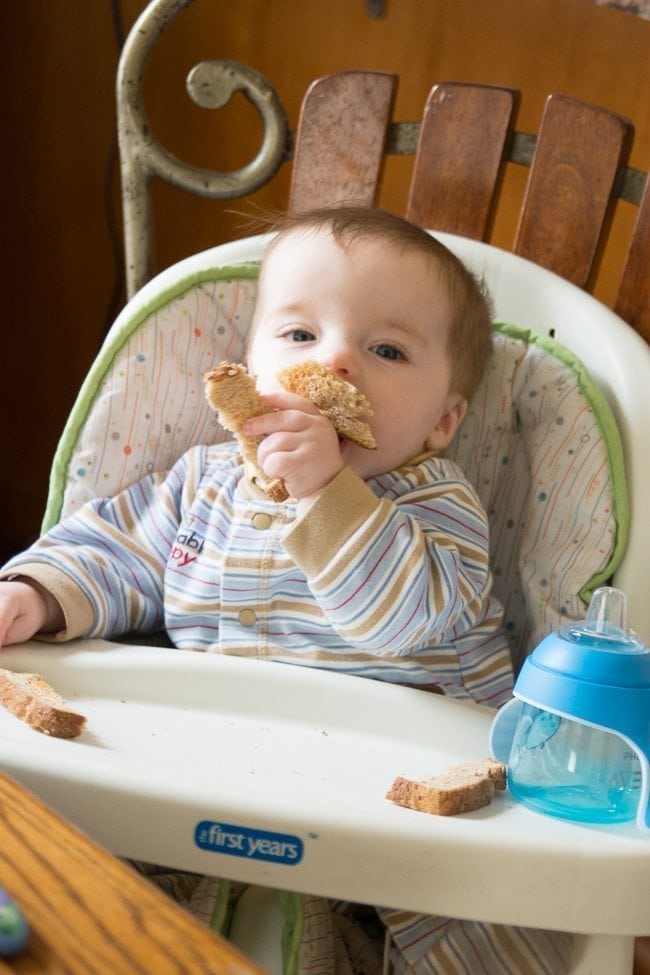
Our pediatrician was super supportive of it – she felt that by having children eat what everyone else is eating from the start, they are less likely to be picky (because they don’t get in the mindset that they get a different meal than everyone else).
Both of my kids are great eaters with no pickiness, so perhaps there’s some truth to it!
I will say that sometimes I do feed Oliver rather than letting him feed himself (so I guess we do a “revised” version of BLW), but it’s always with whatever we are eating. I feel like it makes him feel more a part of the family table.
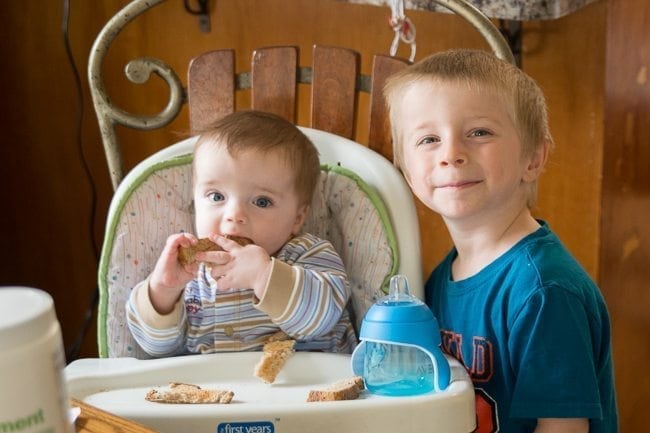
Anyways – that has been our experience with solids. Spoon feeding with pureed foods is also a great option to consider.
By spoon feeding, you can more easily control how much they are eating, and it’s a little less messy. It’s probably the most common method of feeding nowadays.
This is a GREAT resource to let you know what kinds of foods your baby can try at different ages and stages.
You typically want to start with just a Tablespoon of pureed food here and there and slowly increase the amount and frequency.
According to BabyLedWeaning.com, the main difference between the two methods is this:
The key difference between BLW and traditional weaning, when you think about it, is in the order that children learn to eat. With a puree, they learn to swallow first and then chew, which works fine until they meet a lump. With BLW, the babies learn to chew first and swallowing might come some time later.
So, as with everything, do your research and pick the method that is best for you!
When to Start Feeding Solids
You’ll see different recommendations depending on what doctor you see, which website you read, or what your mom says.
The current recommendation from both the AAP and the WHO is about six months, along with other signs of readiness, which include:
- Be able to sit up assisted (some say unassisted, but I don’t agree. Oliver is almost eight months and can’t sit up completely unassisted, but he is more than ready for solids!)
- Can hold up head unassisted
- Baby is interested in eating – our doctor said this is a big one. Some babies you can’t hold back from eating – that’s how Oliver was. When he was almost six months, he would get so mad when we were eating dinner. He wanted to eat! He was so excited when we started giving him food – and he still is.
- Loss of tongue-thrust reflux
- Have doubled birth weight
If your baby doesn’t want to eat foods at six months, don’t force it. Jack didn’t really start wanting anything besides breastmilk until after seven months. Some babies might not until eight or nine!
You should not introduce solids in an attempt to help your baby sleep through the night.
This is a myth, and it is one that has been busted. Introducing solids is also not a good approach to increase weight gain – in fact, introducing solids can actually slow down growth sometimes!
Also, be aware that some pediatricians aren’t exactly up to date with the current research and recommendations and will still recommend four months. This is well-meaning, but it’s not the current recommendation.
This is my favorite resource for introducing solids.
What Foods to Start With
Traditionally, parents start their child on a single grain cereal such as oatmeal or rice. However, this is not necessary or even recommended anymore.
These really don’t have much (if any) nutritional value, and you don’t have to start with them. Many parents just skip them entirely.
Our pediatrician said that avocados or bananas are a great first food. Oliver’s first food was avocado, and he absolutely loved it.
He really enjoys bananas as well.
Some people say you should avoid introducing “sweet” food like fruits until they are established on more bland vegetables, but this wasn’t an issue with either of my boys.
It’s usually recommended that you wait three days before you introduce something new.
I’m not very good about this (and let’s be real – if you did this, it would take years for them to try all the foods!)
I think it’s good to introduce certain foods that are common allergens one at a time. But I don’t think you really need to wait three days with every. single. food. If you do baby led weaning, you will likely be introducing multiple types of food at a time.
Spices can be added to food whenever your baby is ready. It’s probably a good idea to avoid anything too spicy, but just use your best judgment. I feel like spices make food more interesting for babies.
I would also suggest avoiding too much sodium as well.
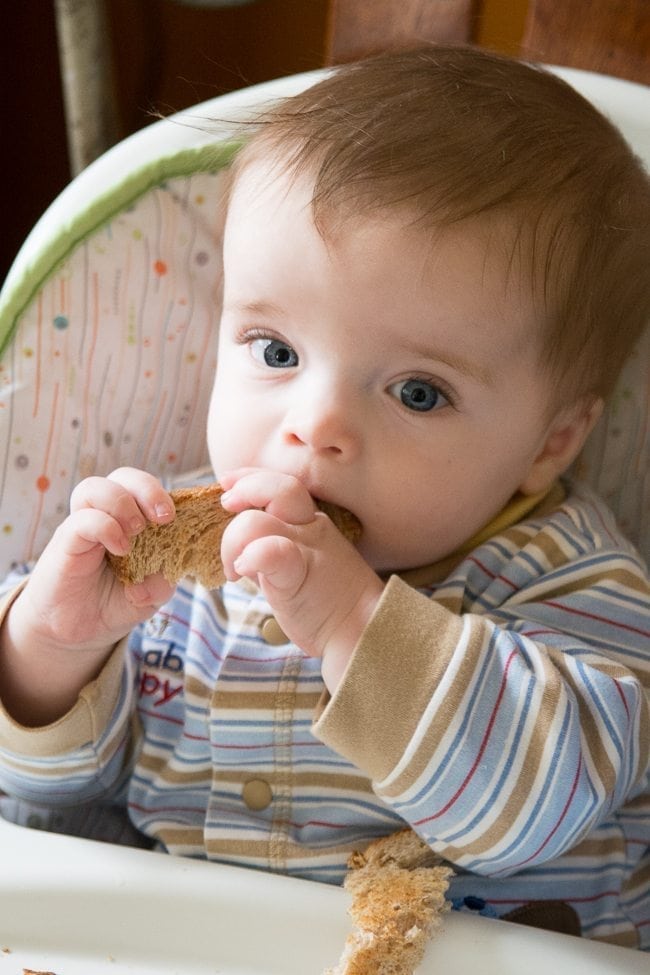
Here are a few great foods to start with:
- Avocado
- Banana
- Sweet Potato (this is a great combo of sweet potato, apple, carrot AND cinnamon!)
- Steamed vegetables (carrots, cauliflower, etc.)
- Pieces of toasts (this is Oliver’s favorite)
- Scrambled eggs
- Pieces of cheese
- Softened pieces of meat (Oliver loves ground turkey and chicken)
What Foods to Avoid
Once upon a time, introducing common allergens like peanuts, egg whites, etc. were delayed.
Now, current research shows that introducing them earlier may actually help prevent allergies in the future. So, there’s really not a lot of foods off-limits for the first year.
If there is a history of allergies in the family, though, it’s a good idea to consult with your doctor or allergist for when to introduce certain foods. Chances are, they will have you introduce those as first foods!
You should still avoid anything containing honey for the first year to avoid the risk of botulism.
It’s also a good idea to avoid anything with too much sugar, added salt, etc. Just be smart about it!
When and How Often
I’m in several parenting/breastfeeding support groups on Facebook, and it’s interesting to see some of the commentaries especially in regards to introducing solids.
A lot of women come in there with some really weird/off base advice that their pediatrician or mom or neighbor gave them – such as that their baby only needs 10 ounces of breastmilk/formula a day, and that solid foods should be their primary source of nutrition by six months.
This is not true.
As I said earlier, until the age of one, your child’s main source of nutrition should still be breastmilk or formula.
I know with breastmilk, the amount of breastmilk a baby needs doesn’t change substantially from about six weeks to one year – your child should be getting about 24-30 ounces a day in that time period until about 11months – and at that point, the average is around 19 ounces a day.
I believe it’s 26-34 ounces of formula a day.
If you are exclusively breastfeeding with no bottles, just continue to feed on demand. So don’t cut out breastfeeding or formula sessions in place of solids!
It’s best to offer breastmilk or formula first, and about 20 minutes later, offer solids. You can start out just once a day, or once every few days, and gradually increase the amount of food they get.
I personally never kept track. Some days my kids would eat a lot, other days not so much. I just let them nurse on demand and eat when we ate. It worked well for us and was not stressful.
Other Liquids
Around six months, you can start to introduce other liquids, though they should be kept to a minimum.
If you are breastfeeding, breastmilk is almost 90% water, so additional water isn’t really necessary. Between 4 and 6 months, limit extra water to two ounces.
After six months, you can offer a little more water, but try not to do it in excess (maybe just a few sips to accompany meals.) Here is a great resource on water and infants.
Six months a great time to start introducing a cup or sippy cup.
If your baby refuses a bottle, they may be more keen to taking breast milk or other liquids from a cup or sippy cup.
Our FAVORITE sippy cups are the Miracle 360 ones. They work great!
Juice, soda pop, and other sugary drinks should not be given. The AAP recommends no fruit juice before the age of one – so really, just keep the majority of your child’s liquids to breast milk or formula!
What About Gagging?
It’s scary to see your baby gag – but rest assured, gagging when introducing solids is normal. Choking, on the other hand, is not!
From babyledweaning.com:
Gagging is actually a safety response to food travelling too far back into the mouth so when we see our babies gagging they are actually handling the problem and it’s best just to keep calm (or at least look calm) and wait until it passes. Choking, you will know about. The baby looks panicked, no or very little sound can come out, and lips may actually start turning blue. Be smart, educate yourself and know how to act quickly.
I highly recommend taking an infant CPR class before your child is born. Honestly, I feel like it’s something they should educate parents on thoroughly before they even leave the hospital!
What if my baby won’t eat solids?
Some babies won’t take as easily to solids, and typically, this isn’t an issue. If baby doesn’t seem interested around six months, wait a few weeks and try again.
You can always switch up what you are offering and how you are offering it to see if baby responds in a different way.
Most children will eventually get used to solids and eating them – but if you are concerned that they have some kind of issue with eating – which does happen – you can always talk with your pediatrician and your child can be evaluated to see if feeding therapy is necessary.
However, in most situations, you just need to keep offering and eventually baby will get the hang of it.
Best Products
There are a lot of great products out there to help you feed your baby – no matter what method you choose. Here are a few things I recommend:
- Under high chair mat
- Space Saver High Chair – this is great if you don’t have a lot of extra room.
- CoolIt Plate – this is great for cooling down hot food fast!
- Soft-tip infant spoons
- Soft divided plates
- Food Freezer Trays (for freezing homemade purees)
- FunBites Food Cutters
- Baby Food Feeder – these can be fun for babies who are wanting to feed themselves.
There’s No One Right Way to Do it
I think sometimes people would see me let Oliver eat whatever we are eating, and that I somehow am judging them for not doing that.
Let me assure you – I wasnot!
Most parents just do the best they can with their babies, and what the best is varies from baby to baby, even within the same family. Listen to your mama or daddy gut – it’s usually right!
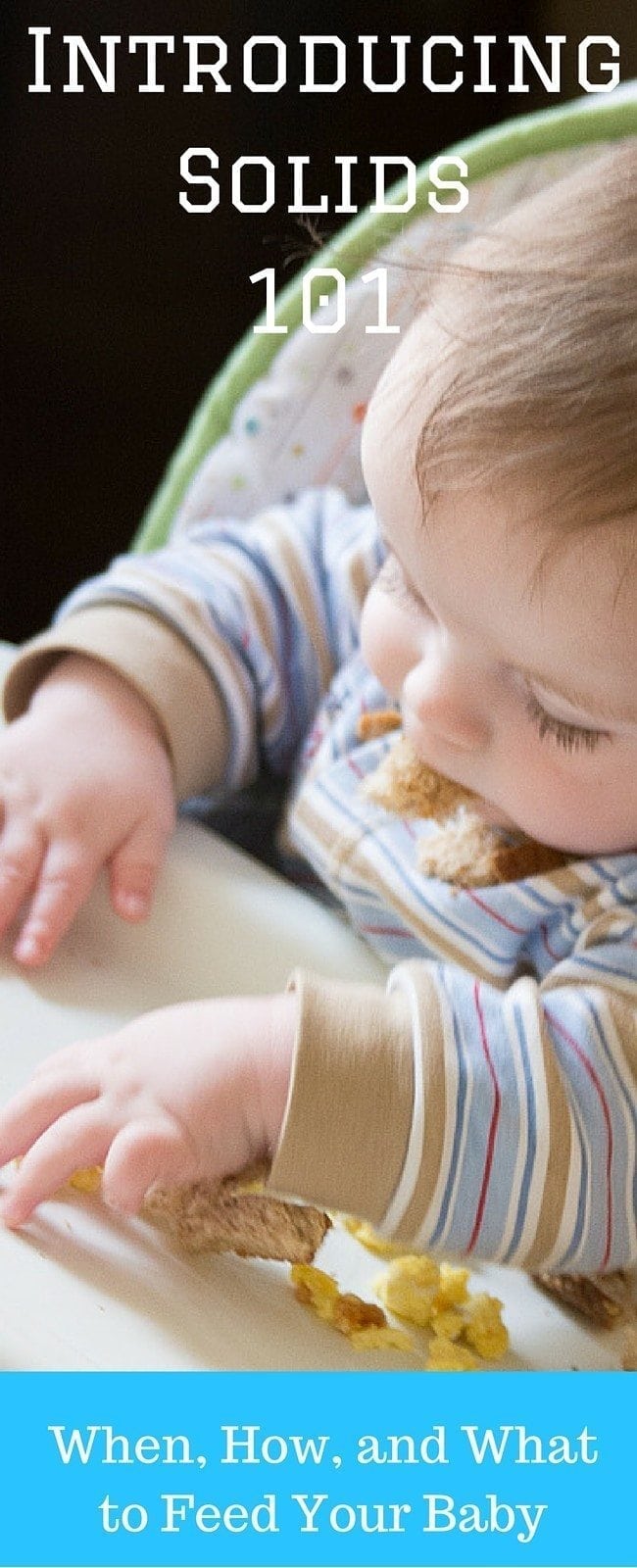
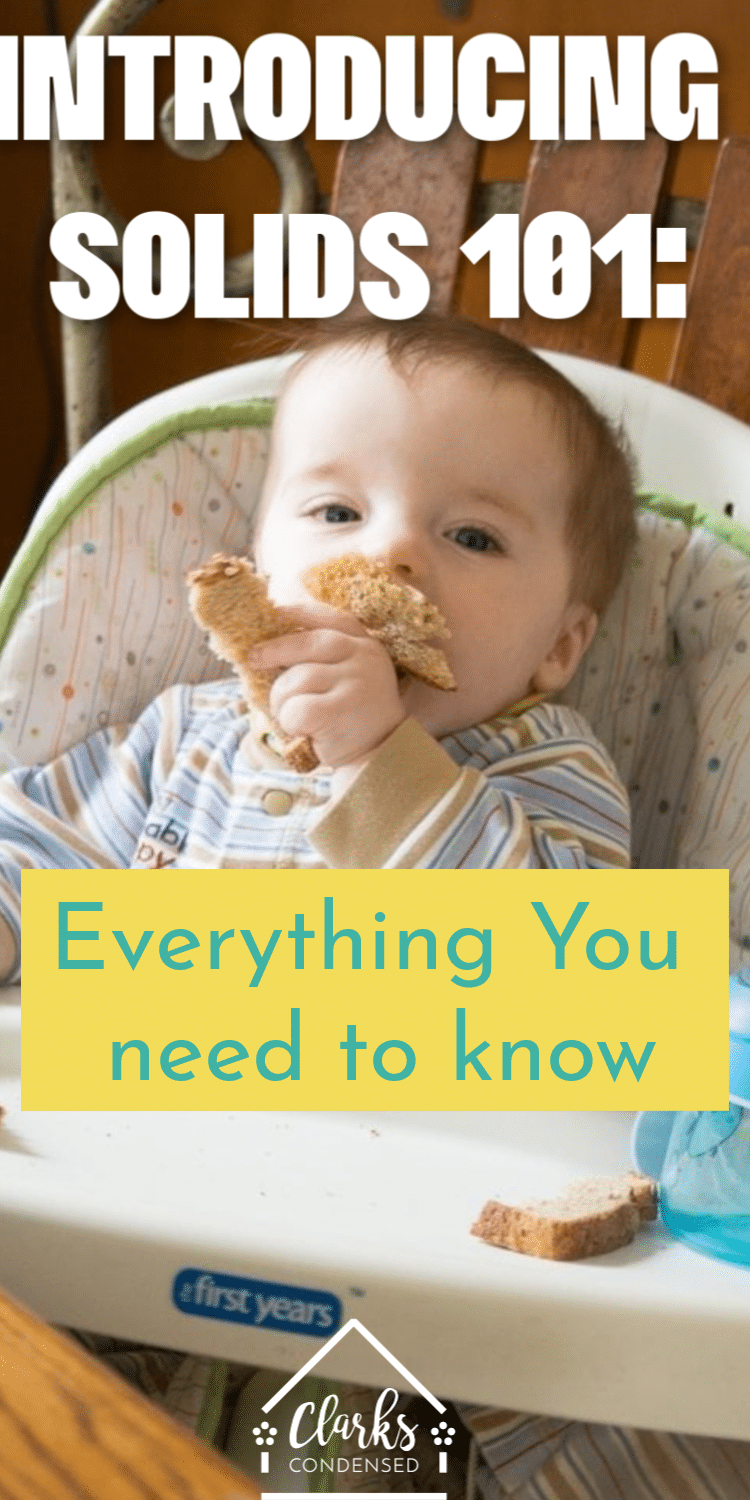

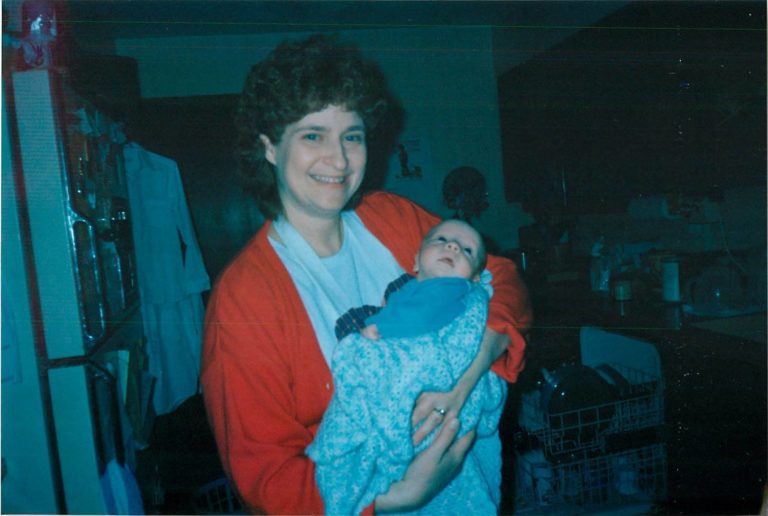
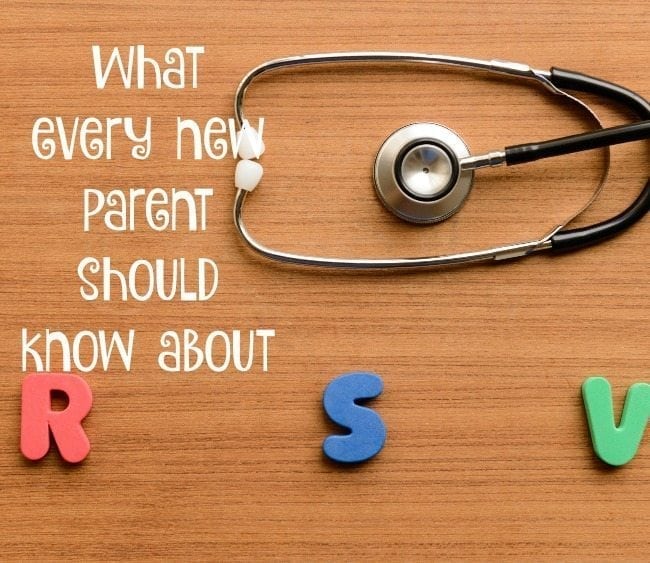

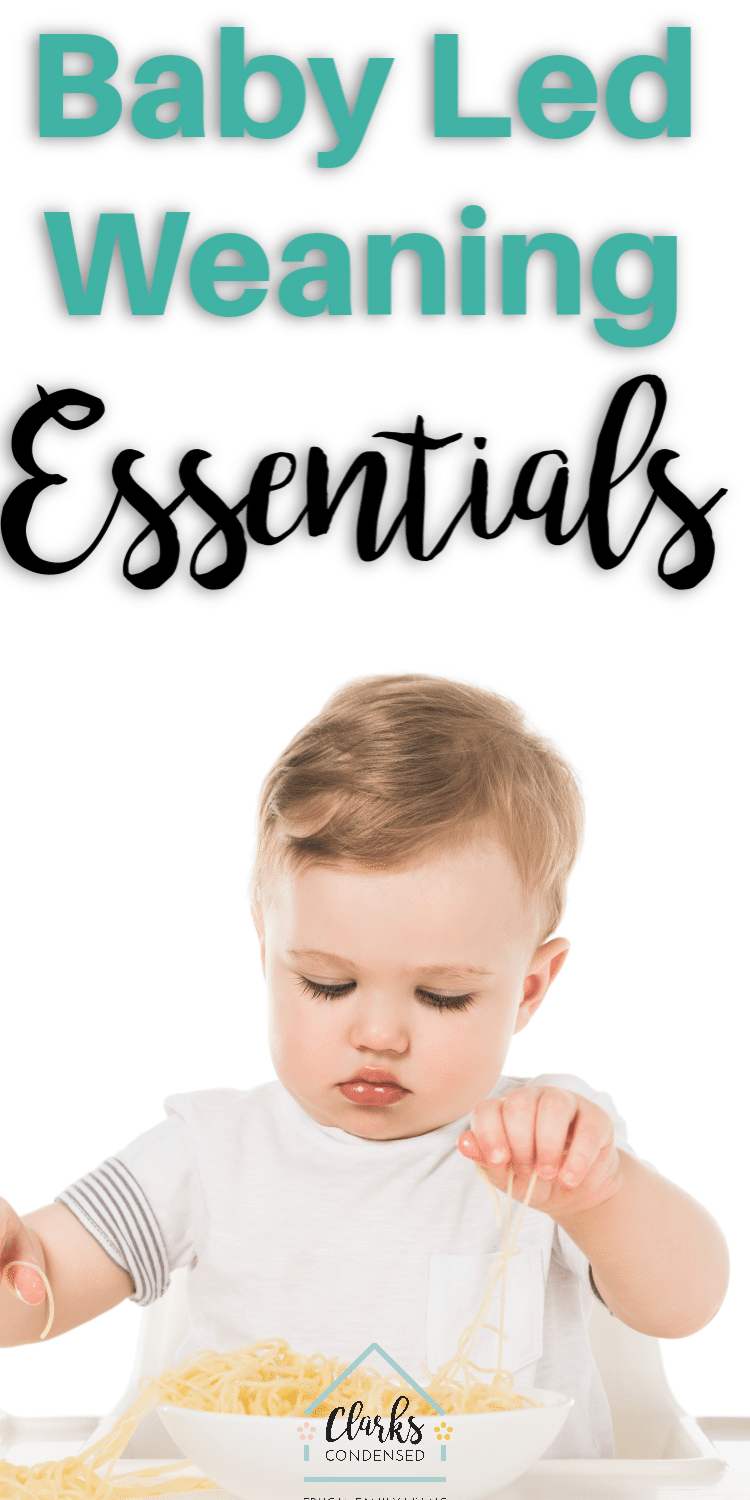

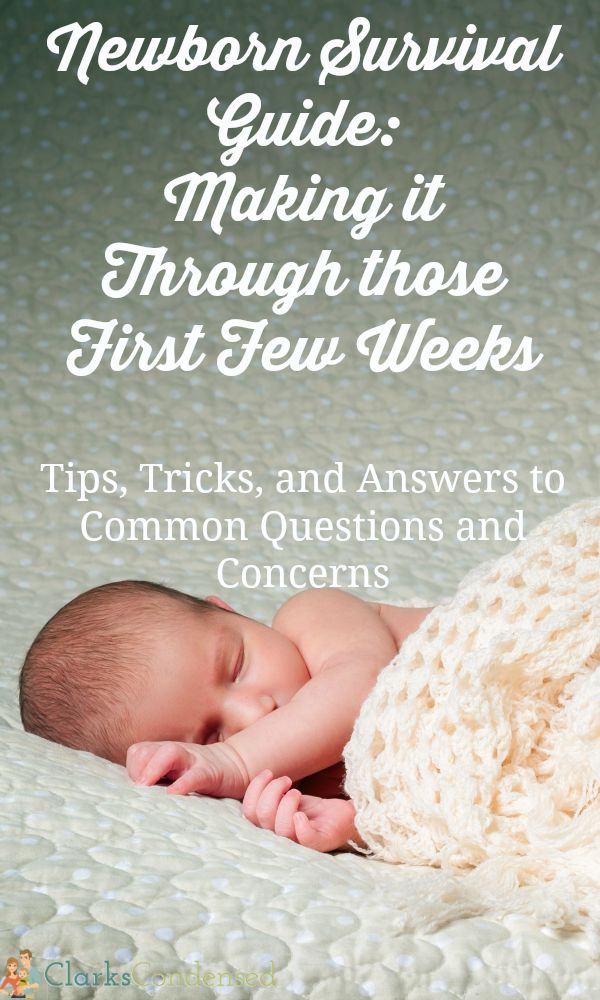
What great information for new moms! Introducing solids to babies can be tricky, so this is really helpful.
Great advice. Adorable baby!
There is so much great information here! I’ll be sure to pass it on to my new mommy friends!
Thanks!
I’m pretty sure I didn’t do well with following the “rules” of the time with feeding my kids. They didn’t get baby food at all and were almost a year old before they had anything other than my milk. They have always been great eaters though.
I think that’s totally great! I know you are a great mom, and you did what was best for your kiddos. My boys never wanted baby food!
Great info! I have three boys, and luckily, it was easy for us to introduce them to solid food. When they started to express interest in eating food, that’s when we knew that it’s time for us to feed them real food.
I think that’s a great time to start feeding them!
There is a baby on the way for my neighbor, we were just talking about breast feeding vs formula options. Your article is so comprehensive and full of so much info Im going to forward it to Milly! Thanks
I hope that she finds it helpful! 🙂
Great information! Well said. My daugher’s (who are 21 and 19) were just asking me about how you know when to start feeding babies real food.
I’m glad you found it helpful! All babies are different – it’s good to know the signs of readiness though 🙂
I had two very eager eaters and one who was happy to nurse or have a bottle, it took some time to convince him to eat foods. All babies are so different.
It’s so true! My first son took awhile to want to eat at all. Oliver is a bit more voracious 🙂
This information is so great Katie 🙂 We have always started purees, but maybe with our next baby we will try this 🙂 Thanks!
Thanks, Charbel! I definitely think it’s easier in some ways (though purees are great, too!)
All of my kids were different when it came to introducing foods. Great info.
Thank you! Kids really are all so different.
Passing along to my sis in law! Thanks for sharing~